Modern banking relies on the smooth operation and security of its core platforms, making Temenos T24 testing a crucial component of system assurance. Applying a mix of functional testing, regression testing, and end-to-end testing ensures that all operations within banking systems are accurate, compliant, and reliable. These testing methods help financial institutions deliver consistent services and maintain trust in their banking software systems.
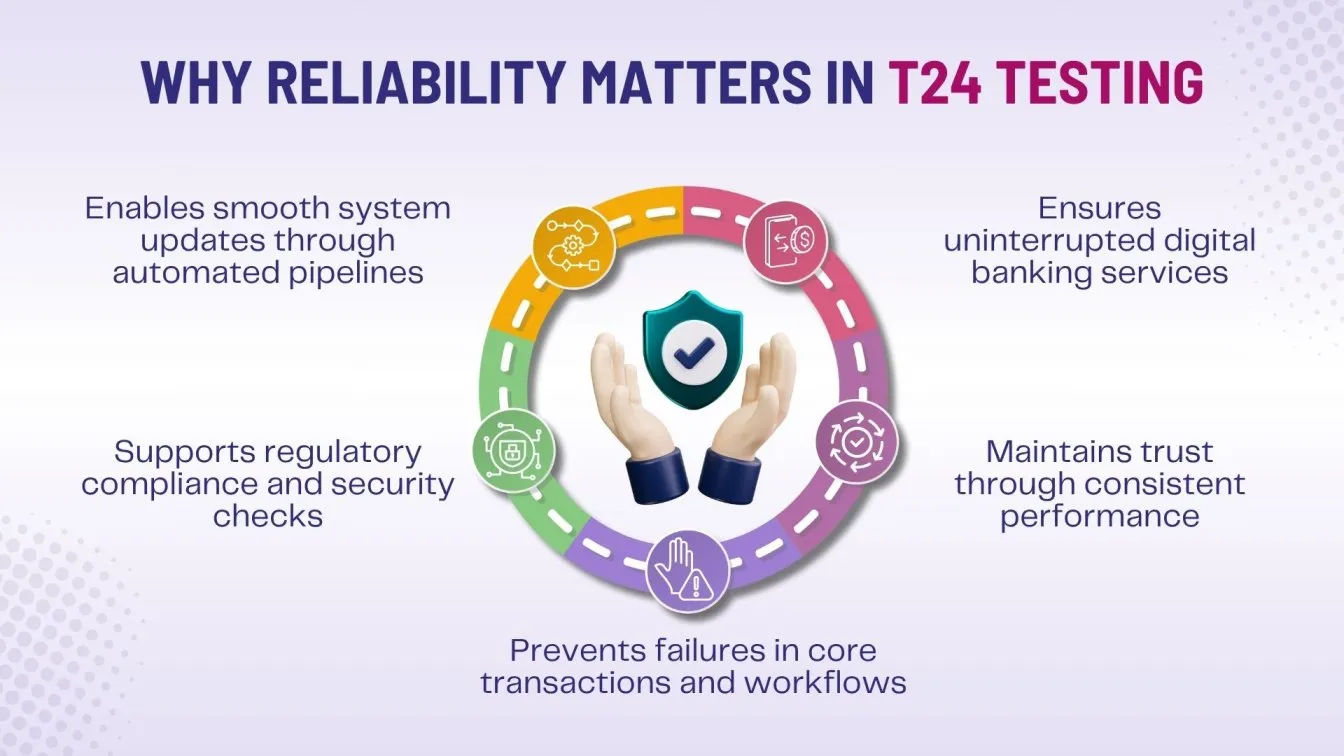
To improve reliability, teams should incorporate test automation into a stable CI/CD pipeline. A strong performance testing framework checks how the system performs under load, while effective data security solutions protect important security data. Together, these practices support the long-term stability and performance of the T24 and Temenos Transact environment.
What’s Next? Keep reading to discover:
🚀 Temenos T24 Testing - What it is and why it matters in core banking.
🚀 Testing Types - Key methods like functional, regression, and performance testing.
🚀 Improving Reliability - Metrics, tools, and scenarios that boost test reliability.
🚀 Reducing Banking Risks - How T24 testing supports secure, real-time operations.
🚀 Final Thoughts - T24’s role in modern, agile, and digital banking.
What Is Temenos T24 Testing?
Temenos T24, also referred to as Temenos Transact, is a widely adopted core banking system used by financial institutions to manage retail, corporate, and private banking operations. It enables banks to manage customer data, accounts, loans, deposits, and regulatory workflows within a centralized, real-time environment. Known for its modular and scalable design, Temenos T24 empowers banks to accelerate product innovation, ensure compliance, and improve operational efficiency.
To support a successful implementation, banks follow a structured project lifecycle from planning to production, where Temenos T24 testing plays a critical role in ensuring data security, integration accuracy, and overall banking reliability.
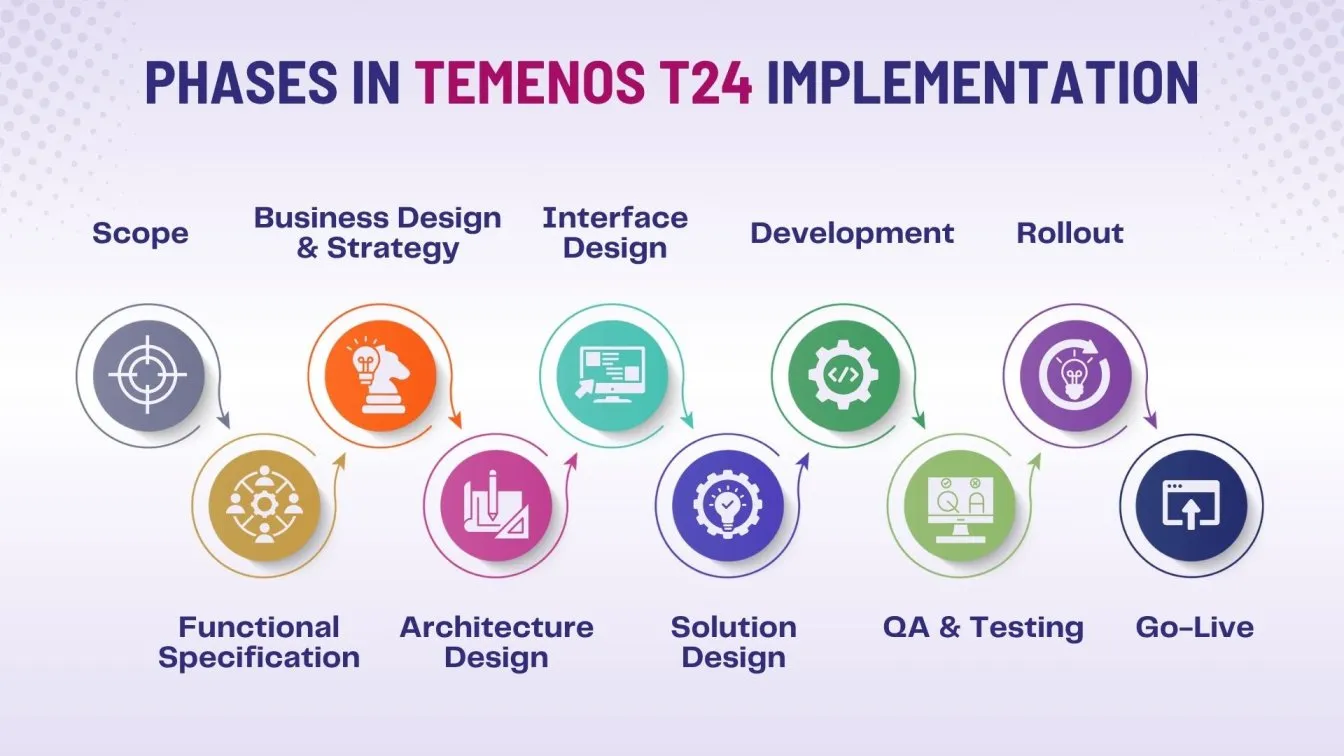
1. Scope: This initial phase defines the project’s scope and objectives, identifying which banking core systems and modules will be implemented. It aligns stakeholders, sets expectations, and helps structure the upcoming testing phases to support end-to-end testing goals.
2. Functional Specification: Business teams document detailed requirements, including workflows, user roles, compliance logic, and reporting. These documents form the foundation for functional testing software and help validate that the configured system matches real-world banking use cases.
3. Architecture Design: A technical blueprint is created that includes infrastructure setup, databases, application servers, and integration paths. Planning this correctly ensures that software performance testing can be executed smoothly across the system later.
4. Interface Design: In this phase, Temenos T24 is integrated with external applications like payment gateways, KYC/AML tools, and reporting systems. Interface design includes defining APIs, data mapping, and error-handling logic, all of which are validated through end-to-end testing.
5. Solution Design: The bank's functional and technical requirements are translated into system-level configurations. This includes setting up interest calculations, product definitions, and workflows. A solid solution design reduces defects and improves the effectiveness of software test automation.
6. Development: During development, parameters are configured, custom scripts are built, and integrations are developed based on the solution design. This phase involves continuous validation, early regression testing, and preparation for downstream QA phases.
7. QA & Testing: At this stage, the configured system is thoroughly tested for accuracy, stability, integration, and performance. The goal is to ensure that the platform functions correctly and consistently across various banking operations while maintaining reliability in testing.
8. Rollout: The configured solution is prepared for deployment. Activities like data migration, user training, environment setup, and trial runs are completed. Special attention is given to validating data security software and user readiness.
9. Go-Live: The final deployment phase, where Temenos Transact goes live in the production environment. Real-time performance is monitored, and any final issues are addressed. This ensures a seamless transition and marks the completion of the CI/CD pipeline with stable output.
Types of Testing Performed in Temenos T24
Temenos T24 testing involves a range of methods to validate functionality, integration, performance, and data security. Each testing type plays a key role in ensuring the platform runs smoothly, reliably, and securely across different banking modules and environments.
Types of Testing in Temenos T24:
Methods to Improve T24 Testing Reliability
Improving reliability in testing for Temenos T24 requires a structured strategy that emphasizes real-world validation, critical module coverage, performance observation, and continuous monitoring. The following methods help ensure that Temenos T24 Transact remains stable, scalable, and secure across all banking operations.
Define Reliability Metrics
Tracking clear and consistent reliability metrics helps quantify how dependable your T24 system is across environments. These metrics are critical in measuring overall system quality, especially for large-scale banking systems.
Why it matters:
Measurable goals help evaluate the effectiveness of the testing strategy, highlight areas of concern, and support decisions about production readiness.
What to track:
- MTBF (Mean Time Between Failures): Calculates how long the system operates without failure, ensuring a reliable banking core system.
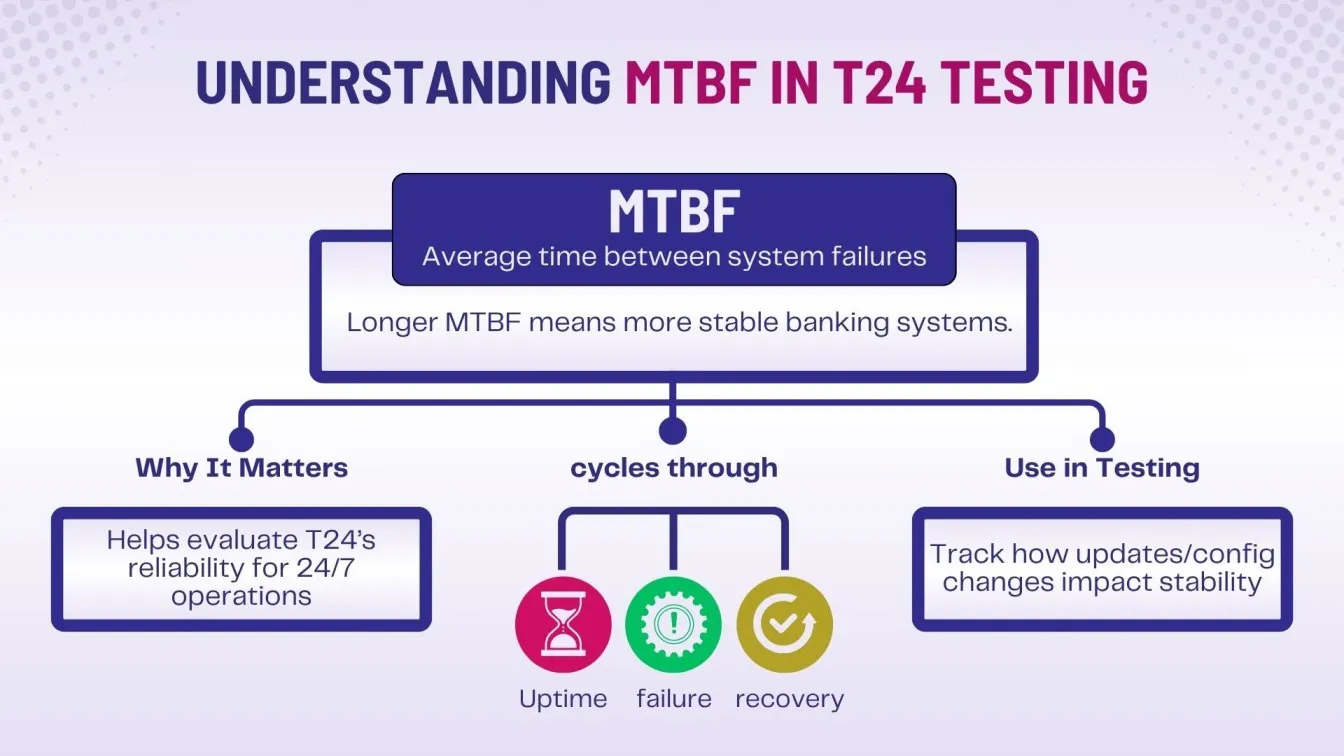
- System Uptime Percentage: Measures the availability of T24, with targets like 99.9% ensuring uninterrupted 24/7 banking access and compliance with service standards.
- Error Rate: Monitors functional or system-level failures during test execution, useful for regression and performance tracking.
- Stress Response Time: Evaluates how quickly Temenos T24 responds when system load increases, essential in performance testing.
- Transaction Throughput: Measures how many transactions per second the system can handle efficiently under volume load.
Identify Critical Modules to Test
All T24 modules are not equal in risk or business impact. Focusing on high-priority modules ensures the stability of critical financial services.
Why it matters:
Testing efforts should be aligned with modules that directly affect customer operations, financial reporting, and regulatory compliance.
Modules to focus on:
- Funds Transfer: Requires precise and secure processing, making it essential for functional and end-to-end testing.
- Loan Origination: Involves business rules, interest rates, and approval paths. It requires detailed functional testing and regression testing of software to prevent financial errors.
- Customer Onboarding: Integrates with KYC and AML systems. Ensuring secure API workflows and data accuracy is crucial for compliance and customer satisfaction.
- Balance Inquiry: Often used across digital channels, this feature must provide accurate data in real-time under a high user load.
- Daily Interest Calculation: Recurring financial logic that needs regression testing to ensure interest calculations remain consistent after system updates.
Design Realistic Test Scenarios
Go beyond basic test cases to simulate real-world banking operations. Test conditions should reflect user behavior, usage patterns, and operational risks.
Why it matters:
Temenos T24 must perform correctly not only under ideal conditions but also during stress, high-volume transactions, and failure scenarios.
Scenarios to simulate:
- Long-Duration Testing: Keep the application running for 24 to 48 hours to observe memory consumption, application behavior, and system fatigue.
- High-Volume Transactions: Simulate millions of transactions using JMeter or LoadRunner to validate transaction load handling and response time.
- Crash and Recovery Testing: Simulate system failures or server shutdowns to test how well the application can recover without data loss.
- Memory Leak Detection: Monitor memory usage patterns for leaks that can affect performance and long-term reliability.
- Database Consistency Checks: Ensure that after heavy operations, all records remain accurate and aligned with system rules and data security policies.
- Concurrent User Simulation: Validate system performance with thousands of concurrent users accessing different modules.
Use the Right Testing Tools
The effectiveness of T24 testing depends heavily on tool selection. A smart mix of automation, performance, and monitoring tools ensures wide coverage and faster validation.
Why it matters:
The right tools improve test speed, accuracy, traceability, and integration with CI/CD, enhancing both functional and performance testing processes.
Recommended tools:
- JMeter / LoadRunner: Ideal for load testing, simulating thousands of transactions, and measuring system endurance.
- Grafana + Prometheus: Real-time system metric monitoring for CPU, memory, and transaction performance during testing.
- Dynatrace / New Relic: Application monitoring tools that provide detailed diagnostics, bottleneck analysis, and system behavior tracking.
- Selenium / Postman: Automates UI and API test cases for repeated functional validations.
- TestNG / JUnit: Enables structured execution of unit and functional test cases, supporting reusable and maintainable testing logic.
- CI/CD Integration: Connect all tools to pipelines using CI/CD tools like Jenkins or GitLab to enable continuous testing.
Set Up Reporting and Alerts
Accurate reporting and proactive alerts provide early visibility into test results, performance trends, and potential failures. These support preventive actions and faster debugging.
Why it matters:
Without real-time alerts and structured reports, critical issues may go unnoticed, leading to delays or production risks.
Best practices:
- Failure Logging: Log every failed test case with the module, timestamp, and error message to improve traceability and issue resolution.
- Threshold-Based Alerts: Configure alerts for key thresholds like CPU usage, memory spikes, and transaction failure rates.
- Summary Reports: Generate automated daily and weekly summaries of test status, coverage, error rate, and reliability indicators.
- Root Cause Documentation: Record root cause analysis for every critical defect to strengthen future test cycles and enhance the accuracy of automation test efforts.
- Executive Dashboards: Provide simplified, high-level dashboards for business teams to monitor progress, coverage, and risk exposure.
Banking Risks Minimized by T24 Testing
While traditional core banking systems software focuses on stability and standardization, Temenos T24 (also known as Temenos Transact) stands out with its modularity, real-time processing, and high configurability. These advanced capabilities require a specialized testing approach, making T24 testing significantly more dynamic, continuous, and integration-focused than legacy platforms.
- Real-Time Data Security Management
With real-time data exchange across modules, T24 requires continuous data security testing such as encryption validation, secure APIs, and access control. Supported by data security software, it safeguards sensitive security data, enabling compliant and secure customer service in both retail and corporate banking.
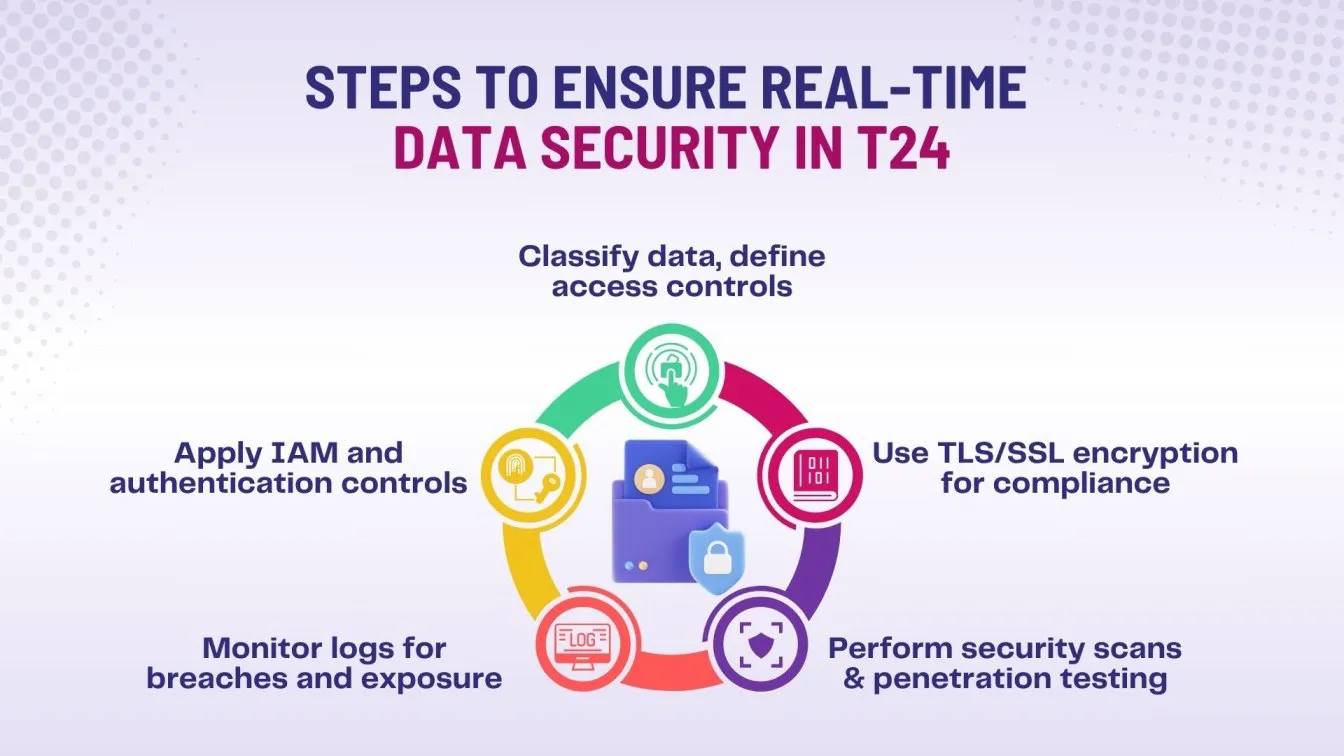
- Highly Configurable Business Logic
T24 allows banks to tailor rules for products, fees, and interest rates. This flexibility in both retail and corporate banking demands precise functional testing to ensure business logic works accurately under all scenarios.
- Continuous Change Handling
T24 supports frequent configuration updates. Automated regression testing within the CI/CD pipeline helps validate ongoing changes efficiently, supporting agile methodologies and maintaining stability through continuous testing regression.
- Dynamic System Integrations
T24 connects with third-party systems like AML, CRM, and mobile banking platforms. Through end-to-end and reliability testing, banks ensure smooth data flow and consistent customer experience across all digital and operational channels.
- Performance at Global Scale
Temenos T24 handles high transaction volumes and real-time operations across regions. Using strong performance testing practices, banks measure testing performance to ensure scalability, uptime, and speed, thereby ensuring reliability for their global digital banking ecosystems.
Conclusion: T24 Testing in Modern Banking
Temenos T24 Transact stands out for its modular design, real-time processing, and flexibility across retail banking, corporate banking, and private banking. To support such a dynamic system, banks must go beyond traditional methods and adopt a testing approach that covers functional testing, regression testing, performance testing, and end-to-end testing, all tailored specifically to T24’s architecture. These methods ensure continuous validation of configurations, secure data flows, and compliance with regulatory standards.
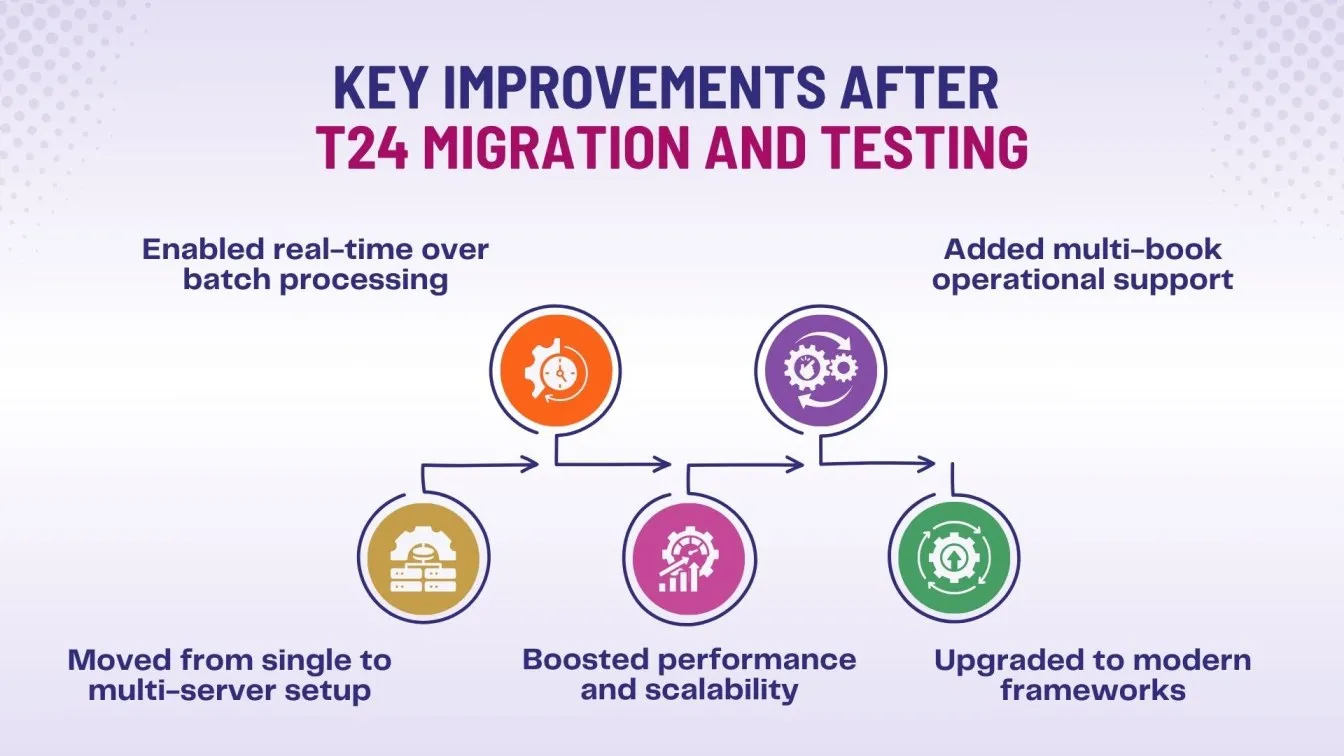
Modern T24 testing also emphasizes test automation frameworks and integration within the CI/CD pipeline, allowing banks to deliver faster updates without sacrificing stability. Strong data security testing ensures that sensitive information is protected at every stage, enhancing the overall reliability of the platform. As a result, comprehensive T24 testing not only minimizes risk but also enables banks to innovate confidently and operate at scale in an increasingly digital world.
Frugal Testing, a leading SaaS application testing company, is renowned for its specialized AI-driven test automation services tailored to meet the evolving needs of modern businesses. Among the comprehensive services offered by Frugal Testing are advanced Fintech Software Testing Services, designed to ensure security, performance, and compliance in financial applications. The company also provides cloud-based test automation services, enabling scalable, efficient, and cost-effective testing solutions for fast-paced digital environments.
People Also Ask
Which software is mainly used at banks?
Banks commonly use core banking systems like Temenos T24, Finacle, Flexcube, and SAP for managing accounts, transactions, and customer data in real time.
Can Temenos T24 be integrated with mobile banking apps?
Yes, T24 offers API support and integration capabilities that allow it to connect with mobile banking platforms and fintech ecosystems.
What is the rules engine in T24?
The rules engine in T24 executes configurable business rules to automate decisions, validations, and workflows without modifying core application code.
What is control testing in banking?
Control testing verifies whether internal controls like approvals, audits, or system access are functioning effectively to reduce operational and compliance risks.
What is the core banking system workflow?
A core banking workflow typically includes customer onboarding, account opening, transaction processing, loan management, interest posting, and regulatory reporting.





%201.webp)

